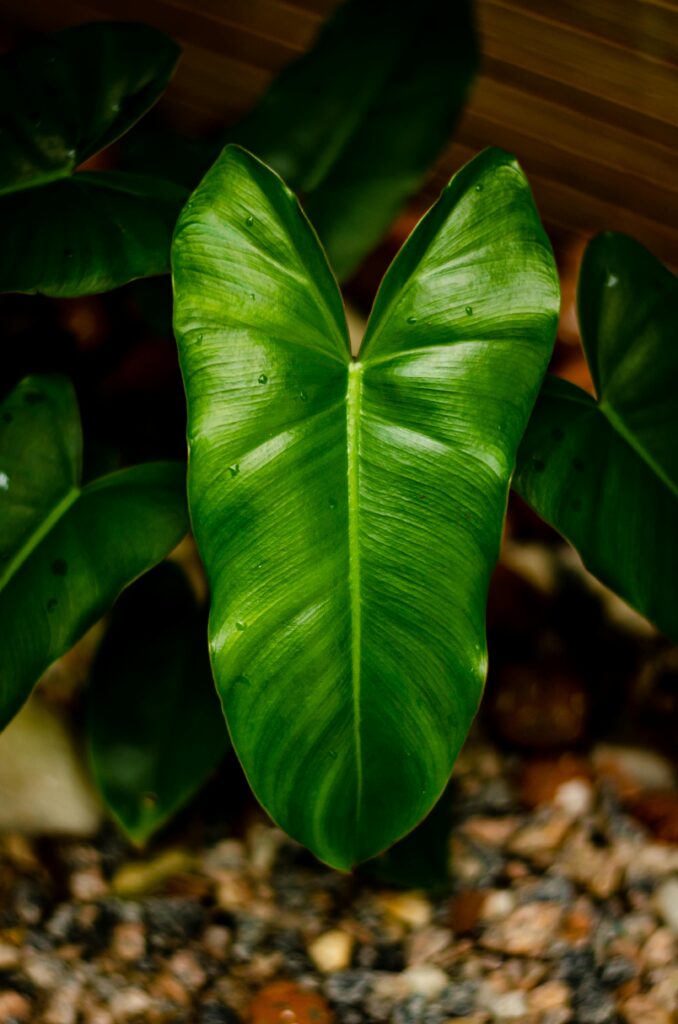The Essential Guide to Basic Philodendron Care

Today, we’re exploring one of the most versatile and beloved houseplant families – the Philodendron. Known for their lush, heart-shaped leaves and trailing or climbing habits, Philodendrons add a lush, tropical feel to any space. With dozens of varieties, from the trailing Heartleaf Philodendron to the Pink Princess, each has unique qualities. Here’s how to care for these plants, plus some tips for special varieties.
1. Lighting Needs
Philodendrons thrive in medium to bright, indirect light. They’ll grow well near a north or east-facing window or a few feet from a south or west-facing window. Most Philodendrons can tolerate lower light conditions but may grow more slowly or develop fewer leaves.
Variety Exception: Variegated varities prefer bright, indirect light to maintain its variegation. Low light may cause it to revert to green. Similarly, Philodendron Pink Princess needs more light to keep its vibrant pink coloring. However, avoid direct sunlight, as it can bleach the leaves.
2. Watering Routine
Philodendrons enjoy slightly moist soil but are prone to root rot, so they don’t like to sit in water. Water when the top 1-2 inches of soil feel dry, typically once a week. During winter, reduce watering frequency as growth slows down.
Tip: Allow water to drain thoroughly after watering, and ensure your pot has drainage holes. If leaves start to droop, it might mean your Philodendron is thirsty, while yellowing leaves could be a sign of overwatering.
3. Humidity and Temperature Requirements
Philodendrons hail from tropical environments and love higher humidity. Average household humidity will be fine for most varieties, but a bit of extra moisture (40-60% humidity) can encourage larger leaves and lush growth. Misting or placing the plant near a humidifier can help, especially in dry climates.
Variety Exception: Philodendron Gloriosum, with its velvet leaves, prefers higher humidity (60-70%) for optimal growth. Philodendron Micans also appreciates higher humidity, but it’s more forgiving if the air is dry.
4. Ideal Soil Mix
A well-draining, chunky soil mix is best for Philodendrons. Combine a regular potting mix with perlite, orchid bark, or coco coir to allow good airflow around the roots. This helps mimic the natural jungle soil that Philodendrons love.
Tip: Avoid compact soils, as they can lead to waterlogged roots. For epiphytic types like Philodendron Brasil, a mix with added bark or sphagnum moss helps keep roots healthy.
5. Fertilizing Tips
Feed Philodendrons every 4-6 weeks in spring and summer with a balanced, water-soluble fertilizer. This will keep them growing strong and lush. Skip fertilizing in winter when the plant’s growth slows.
Variety Exception: Variegated types, like Philodendron Birkin or Philodendron Pink Princess, are sensitive to over-fertilizing, which can cause leaf burn. Use a diluted fertilizer or feed less frequently to avoid damaging the foliage.
6. Pruning and Support
Regularly prune any yellowing or damaged leaves to keep your Philodendron looking fresh. Most Philodendrons benefit from some structural support as they mature; climbing varieties, like Philodendron Brazil or Philodendron Hastatum, will grow larger leaves if provided with a moss pole or trellis.
Variety Exception: Philodendron Gloriosum is a crawler, not a climber, so it doesn’t need vertical support. It grows horizontally, making it perfect for shallow pots that give it room to spread out.
7. Propagation
Philodendrons are easy to propagate! Simply take a cutting with at least one node, place it in water or directly into moist soil, and roots will develop in a few weeks. This is especially easy with vining varieties like Heartleaf Philodendron and Philodendron Brasil.
With these care tips, your Philodendrons are sure to flourish and bring beauty to any room. If you’re looking for a specific variety or have questions about a rare Philodendron, reach out to us at Artistic Foliage. We’re here to help with all your plant needs and love helping you grow your collection. Happy planting!
